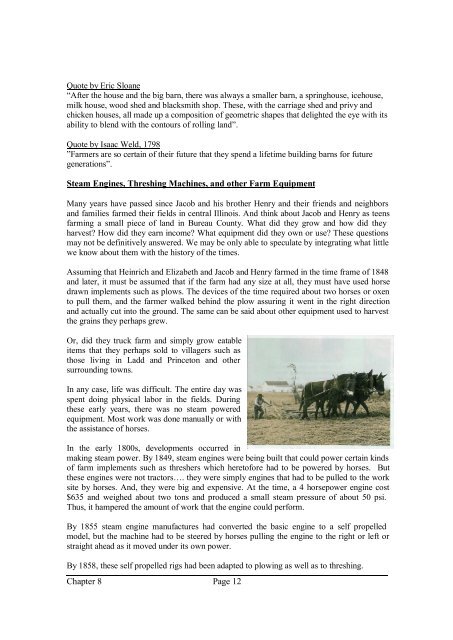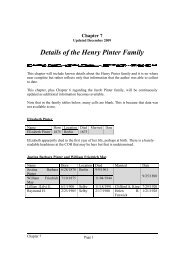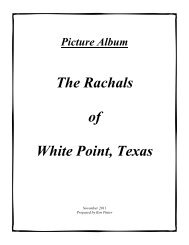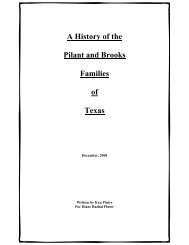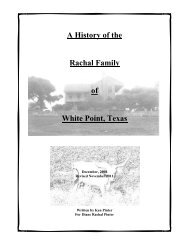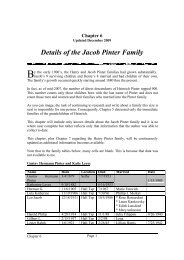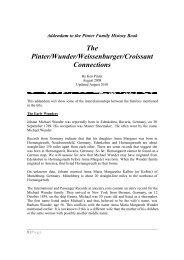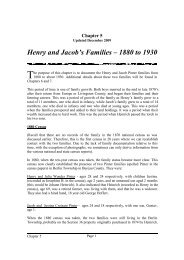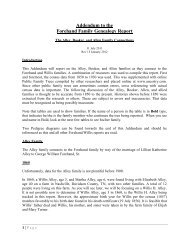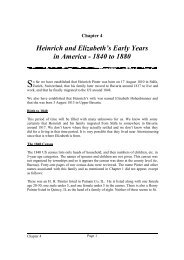Early Farm Life in Bureau County, Illinois, and ... - New Page 1
Early Farm Life in Bureau County, Illinois, and ... - New Page 1
Early Farm Life in Bureau County, Illinois, and ... - New Page 1
You also want an ePaper? Increase the reach of your titles
YUMPU automatically turns print PDFs into web optimized ePapers that Google loves.
Quote by Eric Sloane<br />
“After the house <strong>and</strong> the big barn, there was always a smaller barn, a spr<strong>in</strong>ghouse, icehouse,<br />
milk house, wood shed <strong>and</strong> blacksmith shop. These, with the carriage shed <strong>and</strong> privy <strong>and</strong><br />
chicken houses, all made up a composition of geometric shapes that delighted the eye with its<br />
ability to blend with the contours of roll<strong>in</strong>g l<strong>and</strong>”.<br />
Quote by Isaac Weld, 1798<br />
”<strong>Farm</strong>ers are so certa<strong>in</strong> of their future that they spend a lifetime build<strong>in</strong>g barns for future<br />
generations”.<br />
Steam Eng<strong>in</strong>es, Thresh<strong>in</strong>g Mach<strong>in</strong>es, <strong>and</strong> other <strong>Farm</strong> Equipment<br />
Many years have passed s<strong>in</strong>ce Jacob <strong>and</strong> his brother Henry <strong>and</strong> their friends <strong>and</strong> neighbors<br />
<strong>and</strong> families farmed their fields <strong>in</strong> central Ill<strong>in</strong>ois. And th<strong>in</strong>k about Jacob <strong>and</strong> Henry as teens<br />
farm<strong>in</strong>g a small piece of l<strong>and</strong> <strong>in</strong> <strong>Bureau</strong> <strong>County</strong>. What did they grow <strong>and</strong> how did they<br />
harvest How did they earn <strong>in</strong>come What equipment did they own or use These questions<br />
may not be def<strong>in</strong>itively answered. We may be only able to speculate by <strong>in</strong>tegrat<strong>in</strong>g what little<br />
we know about them with the history of the times.<br />
Assum<strong>in</strong>g that He<strong>in</strong>rich <strong>and</strong> Elizabeth <strong>and</strong> Jacob <strong>and</strong> Henry farmed <strong>in</strong> the time frame of 1848<br />
<strong>and</strong> later, it must be assumed that if the farm had any size at all, they must have used horse<br />
drawn implements such as plows. The devices of the time required about two horses or oxen<br />
to pull them, <strong>and</strong> the farmer walked beh<strong>in</strong>d the plow assur<strong>in</strong>g it went <strong>in</strong> the right direction<br />
<strong>and</strong> actually cut <strong>in</strong>to the ground. The same can be said about other equipment used to harvest<br />
the gra<strong>in</strong>s they perhaps grew.<br />
Or, did they truck farm <strong>and</strong> simply grow eatable<br />
items that they perhaps sold to villagers such as<br />
those liv<strong>in</strong>g <strong>in</strong> Ladd <strong>and</strong> Pr<strong>in</strong>ceton <strong>and</strong> other<br />
surround<strong>in</strong>g towns.<br />
In any case, life was difficult. The entire day was<br />
spent do<strong>in</strong>g physical labor <strong>in</strong> the fields. Dur<strong>in</strong>g<br />
these early years, there was no steam powered<br />
equipment. Most work was done manually or with<br />
the assistance of horses.<br />
In the early 1800s, developments occurred <strong>in</strong><br />
mak<strong>in</strong>g steam power. By 1849, steam eng<strong>in</strong>es were be<strong>in</strong>g built that could power certa<strong>in</strong> k<strong>in</strong>ds<br />
of farm implements such as threshers which heretofore had to be powered by horses. But<br />
these eng<strong>in</strong>es were not tractors…. they were simply eng<strong>in</strong>es that had to be pulled to the work<br />
site by horses. And, they were big <strong>and</strong> expensive. At the time, a 4 horsepower eng<strong>in</strong>e cost<br />
$635 <strong>and</strong> weighed about two tons <strong>and</strong> produced a small steam pressure of about 50 psi.<br />
Thus, it hampered the amount of work that the eng<strong>in</strong>e could perform.<br />
By 1855 steam eng<strong>in</strong>e manufactures had converted the basic eng<strong>in</strong>e to a self propelled<br />
model, but the mach<strong>in</strong>e had to be steered by horses pull<strong>in</strong>g the eng<strong>in</strong>e to the right or left or<br />
straight ahead as it moved under its own power.<br />
By 1858, these self propelled rigs had been adapted to plow<strong>in</strong>g as well as to thresh<strong>in</strong>g.<br />
Chapter 8 <strong>Page</strong> 12


